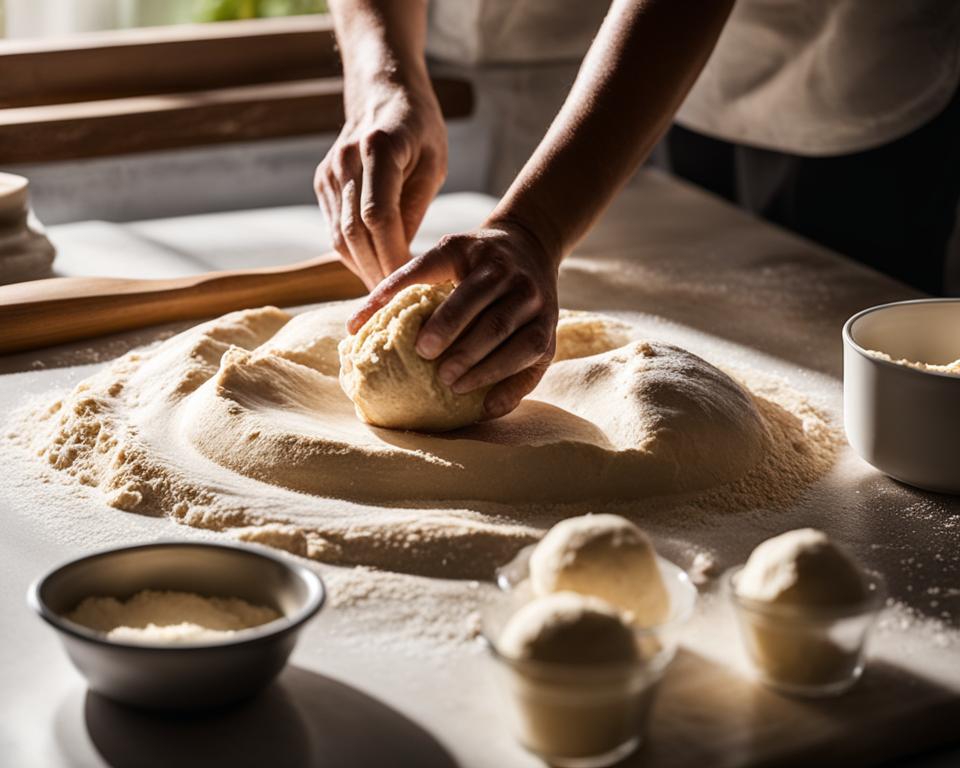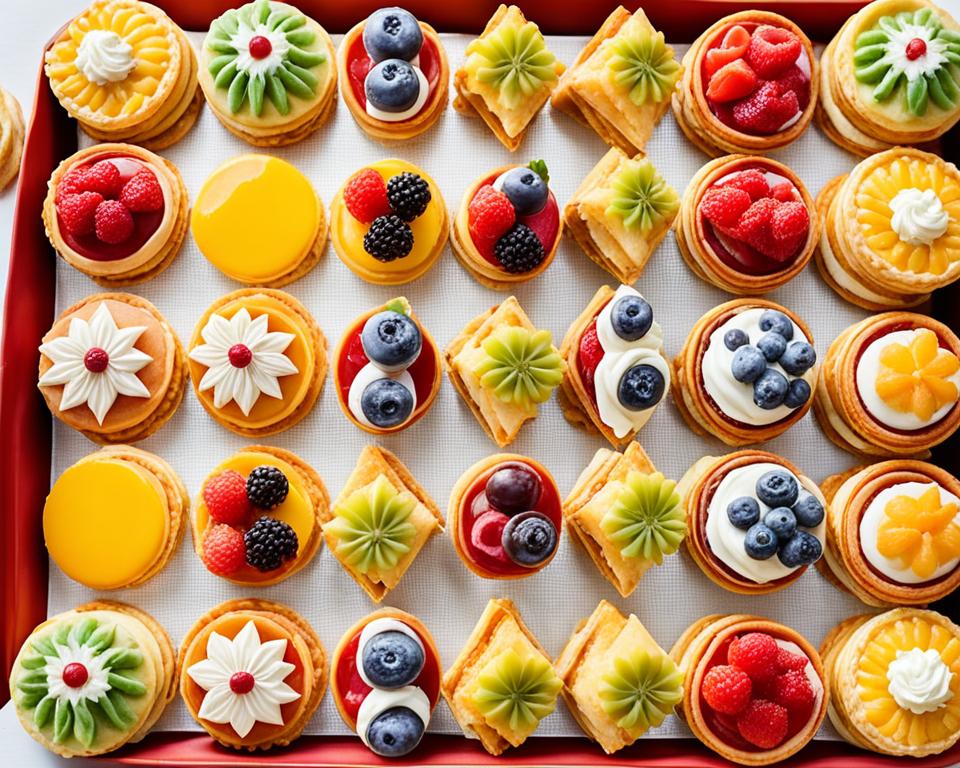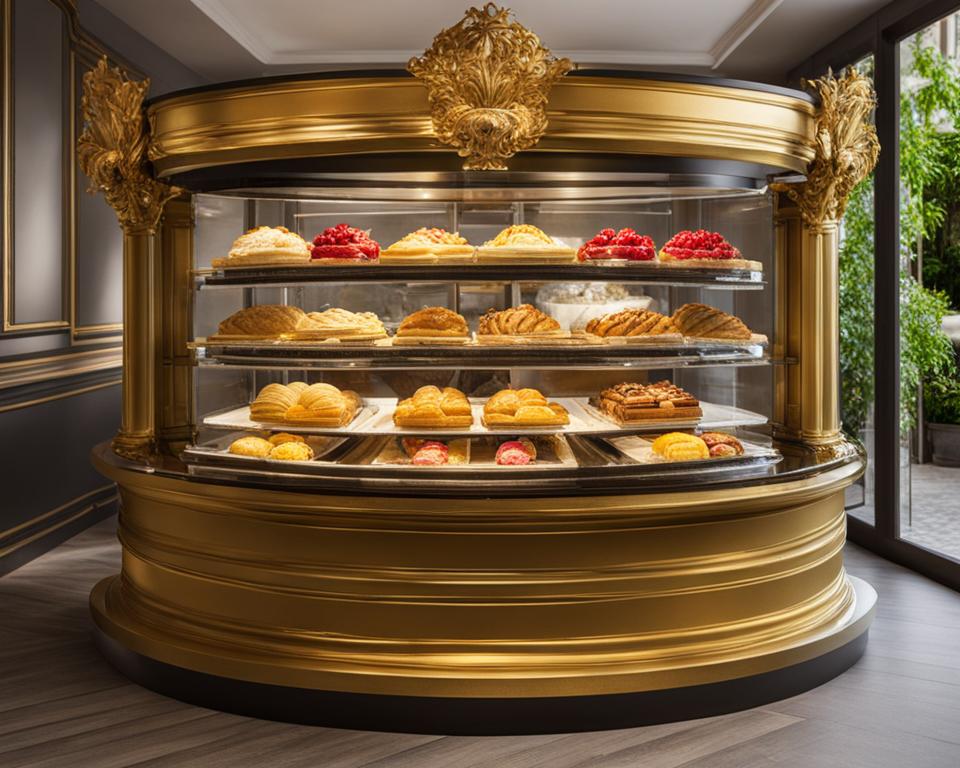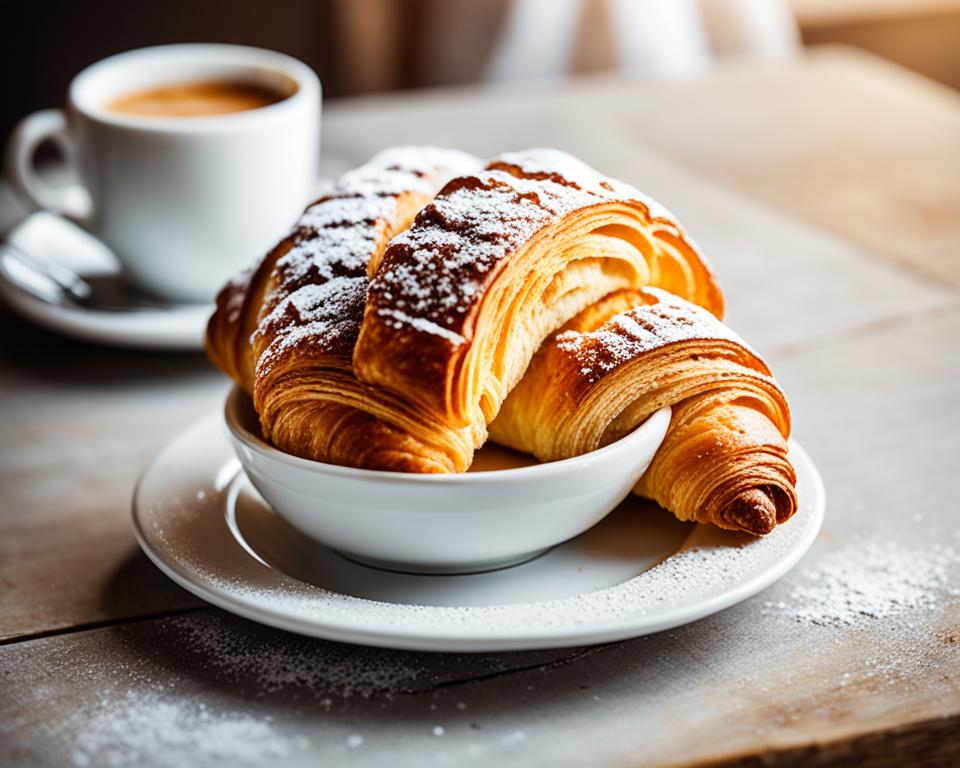Baking can seem daunting for beginners, but with the right tools, techniques, and practice, anyone can become a baking pro. If you’re new to the world of baking and want to learn how to create delicious treats from scratch, this article is for you. We’ll guide you through the basics of baking and provide you with tips for mastering essential baking skills.
Key Takeaways:
- Mastering basic baking skills is achievable with the right tools and practice.
- Understanding baking techniques and terminology is essential for following recipes.
- Start with basic recipes like chocolate chip cookies and vanilla cupcakes to build your skills.
- Troubleshooting baking problems is part of the learning process, and knowing how to fix them is crucial.
- Always follow recipes closely, using precise measurements for the best results.
Essential Baking Tools and Equipment
Before diving into the world of baking, it’s important to have the right tools and equipment at your disposal. Equipping yourself with essential baking tools ensures that you are well-prepared to create delicious baked goodies with ease. Let’s explore the must-have items that every baker should have in their kitchen.
Measuring Cups and Spoons
To achieve accurate measurements in your recipes, reliable measuring cups and spoons are essential. These tools allow you to precisely measure both dry and liquid ingredients, ensuring that you achieve the perfect balance of flavors and textures in your baked goods.
Mixing Bowls
Mixing bowls of various sizes are indispensable in any baker’s toolkit. Opt for mixing bowls made of durable materials like stainless steel or glass. These bowls come in handy for blending ingredients, whisking batters, and incorporating dry and wet components together.
Whisk or Electric Mixer
A whisk or an electric mixer is an invaluable tool that helps create a smooth and well-incorporated batter. Use a whisk for smaller recipes or when a gentle mixing technique is required, while an electric mixer is ideal for larger quantities or recipes that demand vigorous beating.
Spatula
A spatula is a versatile tool that allows you to scrape batter and dough from mixing bowls, fold ingredients gently, and spread frostings and creams. Opt for a heat-resistant silicone spatula to ensure durability and ease of use.
Baking Pans
Baking pans come in different shapes and sizes to accommodate various recipes. Invest in sturdy baking pans made of materials like aluminum or non-stick coated steel. Different recipes call for specific pan sizes and types, such as round pans, loaf pans, or muffin pans, so having a variety on hand ensures you can tackle any baking project.
Oven Thermometer
An oven thermometer is an essential tool for ensuring accurate temperature readings. Ovens can often have temperature variations, and having an oven thermometer allows you to adjust accordingly, ensuring that your baked goods are cooked to perfection.
Cooling Rack
After baking, it’s crucial to allow your creations to cool properly to avoid moisture buildup. A cooling rack provides the necessary airflow, evenly distributing heat and preventing the bottoms of your baked goods from becoming soggy. This essential tool promotes optimal cooling, resulting in perfectly textured treats.
With these essential baking tools and equipment in your kitchen, you’ll be well-equipped to master a wide range of delicious recipes. The right tools not only make the baking process smoother but also help you achieve consistent and impressive results. Now that you have your baking arsenal ready, it’s time to move on to the next section and dive into the world of baking ingredients.
Understanding Baking Ingredients
The quality of ingredients greatly affects the outcome of baked goods. Understanding the different types of baking ingredients is crucial to achieving delicious and successful results. In this section, we will explore the key ingredients used in baking and their roles in creating delightful treats.
Flour
Flour is one of the fundamental ingredients in baking. It provides structure to baked goods and determines their texture. There are various types of flour used in baking, including:
| Type of Flour | Description |
|---|---|
| All-Purpose Flour | A versatile flour suitable for a wide range of recipes, such as cookies, cakes, and bread. |
| Bread Flour | A high-protein flour ideal for yeast-based bread and pizza dough. |
| Cake Flour | A finely milled flour that produces tender and light cakes. |
| Whole Wheat Flour | A whole-grain option that adds a nutty flavor and increased nutritional value to baked goods. |
Sugar
Sugar adds sweetness, flavor, and moisture to baked goods. There are different types of sugar commonly used in baking, including:
- Granulated Sugar: Fine white sugar used in most recipes.
- Brown Sugar: A moist sugar with a caramel-like flavor, available in light or dark varieties.
- Powdered Sugar: Also known as confectioners’ sugar, it is finely ground and often used for frosting and dusting.
- Coarse Sugar: Large-crystal sugar that adds texture and sparkle to baked goods.
Leavening Agents
Leavening agents are responsible for making baked goods rise and become light and fluffy. The two primary leavening agents used in baking are:
Baking Powder: A combination of baking soda, cream of tartar, and a moisture-absorbing agent. It is used in recipes that do not contain acidic ingredients.
Baking Soda: Sodium bicarbonate that reacts with acidic ingredients, such as buttermilk or vinegar, to produce carbon dioxide and help dough or batter rise.
Fats
Fats provide moisture, flavor, and tenderness to baked goods. Common fats used in baking include:
- Butter: Adds richness and flavor to baked goods.
- Margarine: A butter substitute made from plant oils, suitable for vegan or lactose-intolerant bakers.
- Oil: Used in recipes that require a moist texture, such as cakes and quick breads.
- Shortening: A solid fat made from hydrogenated vegetable oils, often used in pie crusts and cookies.
Dairy and Eggs
Dairy products and eggs play crucial roles in baking. They provide moisture, richness, structure, and browning. Common dairy ingredients used in baking include milk, cream, and buttermilk. Eggs, whether whole, yolks, or whites, add structure and stability to baked goods.
Understanding these baking ingredients is vital for achieving baking success. The right combination of flour, sugar, leavening agents, fats, dairy, and eggs contributes to the texture, flavor, and appearance of your baked creations. Experimenting with different ingredients and understanding their functions will help you become a confident and skilled baker.
Baking Techniques and Terminology
Baking is a skill that involves various techniques and terminologies, each playing a crucial role in creating delicious baked goods. Understanding and mastering these techniques will help you follow recipes accurately and achieve the desired results. Let’s explore some common baking techniques and terminologies that every aspiring baker should know:
Mixing Methods:
- Creaming: This technique involves beating together butter and sugar until light and fluffy. Creaming creates a tender and light texture in baked goods, such as cakes and cookies.
- Folding: Folding is a gentle mixing technique used to combine delicate ingredients, like whipped egg whites or whipped cream, with a heavier batter. This method helps maintain the lightness and airiness of the final product.
- Beating: Beating is a vigorous mixing technique that incorporates air into the batter. It is commonly used to whip ingredients, such as egg whites, heavy cream, or butter, to increase volume and create a light and fluffy texture.
Baking Terminology:
When following a recipe, you may come across various baking terminologies. Here are some commonly used terms:
- Preheat: Before starting any baking process, you need to preheat your oven to the specified temperature. This ensures that the oven reaches the desired heat for even baking.
- Bake: Baking refers to the process of cooking food in the oven using dry heat. It is the most common baking method used for a wide range of recipes, including cakes, bread, and pastries.
- Broil: Broiling involves cooking food under direct heat. This method is typically used to brown the tops of dishes or add a crispy texture.
By familiarizing yourself with these baking techniques and terminologies, you’ll be able to confidently navigate through recipes and achieve outstanding baking results. Let’s take a moment to appreciate the creativity and precision that goes into baking:
“Baking is an art and a science. It’s about adding a little extra love, patience, and precision to create something truly special.” – Unknown
Now that you have a good understanding of baking techniques and terminologies, let’s move on to the next section where we’ll explore some basic baking recipes that will help you put your skills to practice.
Basic Baking Recipes
To practice and improve baking skills, beginners should start with basic recipes. Two classic recipes to master are chocolate chip cookies and vanilla cupcakes. These recipes provide step-by-step instructions to follow and allow beginners to become familiar with essential baking techniques.
Chocolate Chip Cookies
Chocolate chip cookies are a timeless favorite that everyone loves. They are simple to make and require basic ingredients that you probably already have in your pantry. Here’s a classic chocolate chip cookie recipe to get you started:
“There’s nothing quite like the aroma of freshly baked chocolate chip cookies. This recipe yields perfectly chewy cookies with a golden outer crust and melty chocolate chips. Enjoy them warm with a glass of milk!”
| Ingredients | Instructions |
|---|---|
|
|
Vanilla Cupcakes
Vanilla cupcakes are a classic and versatile treat. They can be enjoyed plain or topped with frosting and decorations, making them perfect for any occasion. Here’s a simple vanilla cupcake recipe:
“These moist and fluffy vanilla cupcakes are a blank canvas for your creativity. Decorate them with buttercream frosting, sprinkles, or any other toppings you prefer. They’re sure to be a hit at parties and gatherings!”
| Ingredients | Instructions |
|---|---|
|
|
These basic baking recipes are perfect for beginners looking to develop their skills and gain confidence in the kitchen. Experiment with different variations and techniques to make them your own. Happy baking!
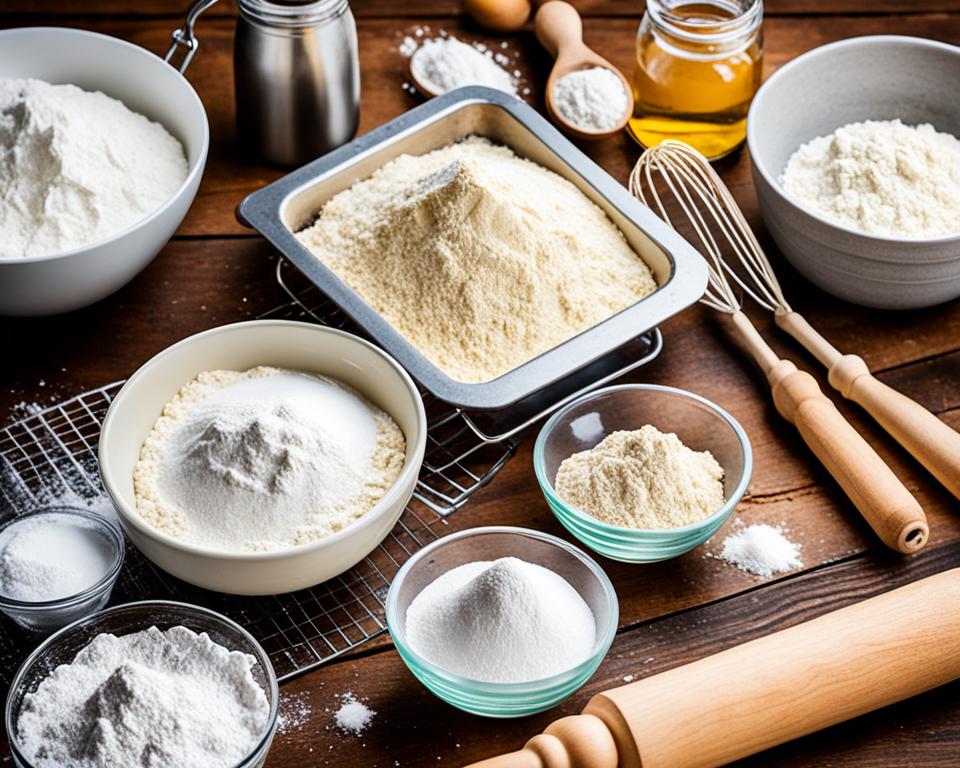
Troubleshooting Baking Problems
Even experienced bakers encounter problems in their baking journey. Don’t worry — it’s all part of the learning process. Identifying and solving baking issues will help you improve your skills and achieve better results.
Burnt Bottoms
One common problem in baking is burnt bottoms. To avoid this, make sure to use the correct oven temperature and baking time as indicated in the recipe. Additionally, consider placing a baking sheet or parchment paper underneath your baking pan to provide extra insulation and prevent direct heat transfer.
Uneven Rising
Uneven rising can be frustrating, especially when your baked goods turn out lopsided or misshapen. To address this problem, check your leavening agents, such as baking powder or baking soda, to ensure they are fresh and not expired. Properly mix your batter or dough to evenly distribute the leavening agents and other ingredients. Avoid overmixing, as it can lead to tough textures.
Soggy or Dense Texture
Avoid soggy or dense texture in your baked goods by properly measuring and mixing your ingredients. Use the specified amounts and avoid making substitutions unless the recipe allows for it. Overmixing or using too much liquid can also result in a dense texture. Follow the recipe instructions closely and refrain from opening the oven door during baking, as it can disrupt the baking process and affect the texture.
By troubleshooting these common baking problems, you can overcome challenges and enhance your baking skills. Remember, practice makes perfect! Experiment with different recipes and techniques until you find what works best for you.
Stick to the Recipes
One important tip for beginners is to always follow recipes closely. Following recipe instructions and using precise measurements is crucial for achieving desired results. Recipes have been tested and developed, so it’s best to trust them and stick to the given instructions.
“Recipes are the roadmap to successful baking. They provide step-by-step instructions and precise measurements that have been carefully tested to ensure the best possible outcome. Deviating from the recipe can lead to unexpected results. So, when starting out, it’s essential to follow recipes diligently.”
By following recipes, beginners can learn the correct techniques and proportions required for each recipe. It’s important to read the recipe thoroughly before beginning the baking process. Pay attention to specific instructions regarding mixing techniques, oven temperatures, and baking times.
Using precise measurements is also crucial in baking. Invest in a good set of measuring cups and spoons to ensure accurate and consistent results. Even small variations can significantly affect the texture and taste of baked goods. Measuring ingredients precisely is a skill that develops with practice, so it’s important to be patient and take your time.
Benefits of Following Recipes:
- Consistent results: Recipes provide a tried-and-tested formula, ensuring consistent outcomes.
- Correct proportions: Recipes specify precise measurements, allowing for the right balance of ingredients.
- Learn baking techniques: Following recipes helps beginners learn essential baking techniques and methods.
- Develop confidence: By following recipes and achieving successful results, beginners gain confidence in their baking abilities.
Quote:
“A recipe is a story that ends with a good meal.” – Pat Conroy
Remember, following recipes is the foundation of mastering baking skills. As beginners gain experience and become more comfortable in the kitchen, they can start experimenting and adding their own twists to recipes. But until then, it’s best to stick to the recipes for consistent and delicious results.
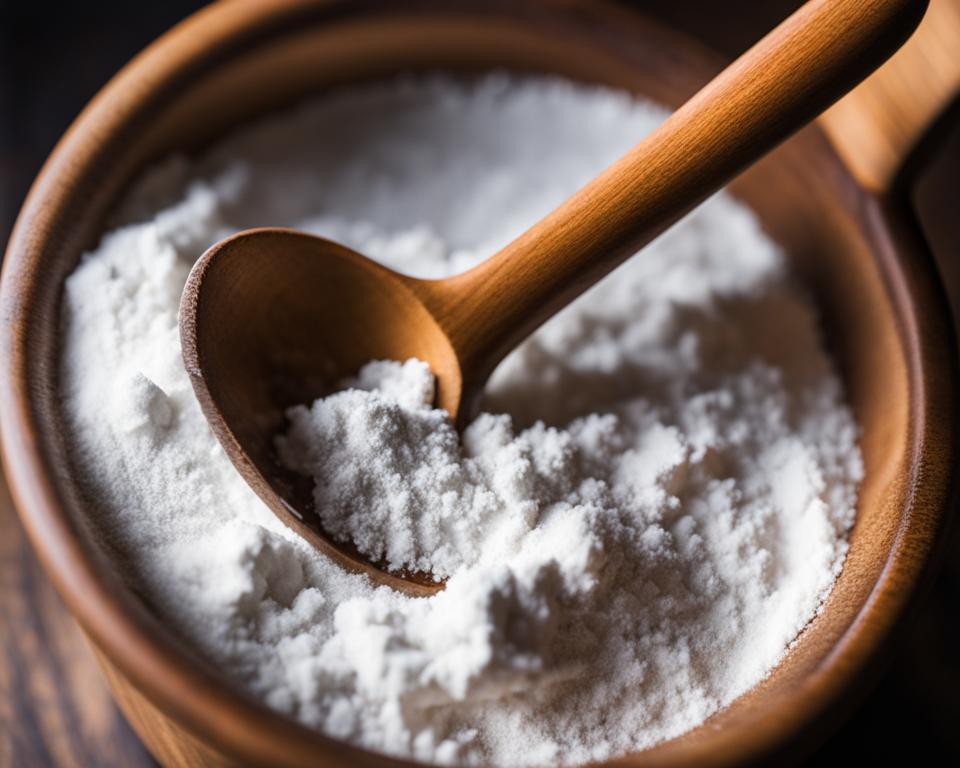
Set up Ingredients before You Start
Before embarking on your baking adventure, taking the time to prepare and organize your ingredients can make a world of difference. Properly preparing and measuring your ingredients sets the stage for success and ensures a smooth and enjoyable baking experience. Let’s take a closer look at how to prepare and organize your ingredients before you start.
1. Preparing Ingredients: Start by gathering all the ingredients required for your recipe. Check the recipe carefully to ensure you have everything you need. If any of your ingredients need to be measured, make sure to do so accurately. This will help maintain the right balance of flavors and textures in your final baked goods.
2. Measuring Ingredients: Precise measurements are crucial in baking. Invest in a good set of measuring cups and spoons for accurate measurements of dry and liquid ingredients. Whether it’s flour, sugar, liquids, or spices, follow the recipe closely and measure each ingredient carefully. Doing so will ensure consistent results each time you bake.
3. Organization: Keeping your ingredients organized is key to a stress-free baking process. Lay out your ingredients in order of use, making it easier to follow the recipe step by step. If certain ingredients require mixing separately, it’s a good idea to group them together. By having all your ingredients easily accessible and in logical order, you’ll save time and minimize the chances of missing an ingredient.
By preparing your ingredients and measuring them accurately, you set yourself up for baking success. The organization of your ingredients helps streamline the baking process and ensures a more enjoyable experience in the kitchen. So, take a moment to gather your ingredients, measure them precisely, and get ready to create delicious treats!
Essential Baking Tools and Equipment
| Baking Tool/Equipment | Description |
|---|---|
| Measuring cups and spoons | Accurate measurement of dry and liquid ingredients |
| Mixing bowls | Containers for combining ingredients |
| Whisk or electric mixer | Tools for mixing ingredients |
| Spatula | For scraping, mixing, and folding ingredients |
| Baking pans | Specific pans for each recipe, such as cake pans or baking sheets |
| Oven thermometer | Ensures accurate oven temperature |
| Cooling rack | Allows baked goods to cool evenly |
Conclusion
Mastering basic baking skills is a journey that requires practice, patience, and a genuine love for the craft. By following the tips and techniques outlined in this article, beginners can take their baking to the next level and improve their techniques.
Remember, honing your baking skills takes time and dedication. Don’t be discouraged if your first attempts don’t turn out perfectly. Baking is an art that requires experimentation and learning from mistakes.
With each baking project, you’ll gain valuable experience and insight that will contribute to your growth as a baker. Embrace the process, keep exploring new recipes, and never stop learning and improving. Before you know it, you’ll be confidently creating delicious treats that will impress friends and family alike.
FAQ
How can beginners master basic baking skills?
Beginners can master basic baking skills by practicing, using the right tools, and following recipes closely. It’s important to start with basic recipes and gradually improve techniques over time.
What are the essential tools and equipment for baking?
Essential tools for baking include measuring cups and spoons, mixing bowls, a whisk or electric mixer, a spatula, baking pans, an oven thermometer, and a cooling rack.
What are the key baking ingredients?
Key baking ingredients include flour, sugar, leavening agents, fats, dairy products, and eggs.
What are some common baking techniques and terminologies?
Common baking techniques include creaming, folding, and beating. Baking terminologies include terms like preheat, bake, broil, and more.
What are some basic baking recipes for beginners?
Two basic baking recipes for beginners are chocolate chip cookies and vanilla cupcakes. These recipes provide step-by-step instructions to help beginners become familiar with essential baking techniques.
How can beginners troubleshoot common baking problems?
Beginners can troubleshoot common baking problems by understanding the issues, such as burnt bottoms, uneven rising, or a soggy or dense texture, and finding the appropriate solutions.
Why is it important to follow recipes closely when baking?
Following recipes closely and using precise measurements is crucial for achieving the desired results. Recipes have been tested and developed, so it’s best to trust them and stick to the given instructions.
What should beginners do before starting the baking process?
It’s helpful for beginners to have all the ingredients laid out and prepared before starting. This includes measuring the ingredients accurately and having them ready to use. Being organized ensures a smoother baking experience.
How can beginners improve their baking skills?
Beginners can improve their baking skills by practicing, being patient, and having a willingness to learn. By following tips and techniques, beginners can hone their baking skills and continue to improve over time.

